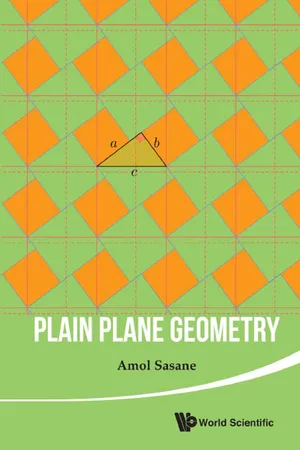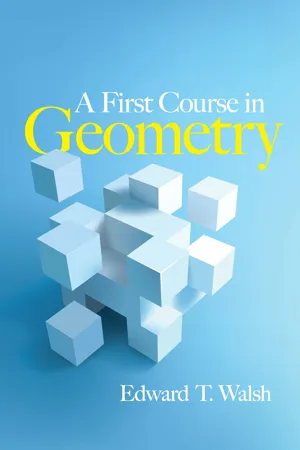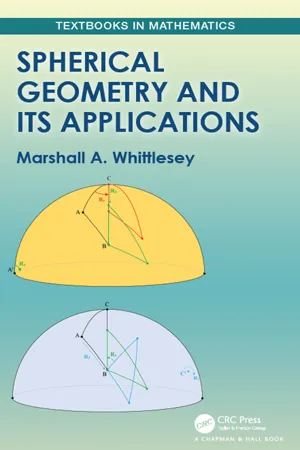Mathematics
Circles
Circles are a set of points in a plane that are equidistant from a fixed point called the center. The distance from the center to any point on the circle is called the radius. Circles are defined by their radius and center, and they have properties such as circumference, area, and relationships with angles and other geometric shapes.
Written by Perlego with AI-assistance
Related key terms
4 Key excerpts on "Circles"
- eBook - ePub
- Dan Pedoe(Author)
- 2013(Publication Date)
- Dover Publications(Publisher)
IICirclesThe circle, in various guises, occurs in many branches of mathematics. In this chapter we shall consider those properties which have the habit of appearing in different contexts. Our methods will be mixed. We shall use Euclidean geometry or analytical geometry, according to our needs at the time. We begin with the consideration of certain one-to-one mappings of the plane onto itself, and the product of these mappings. (See 0.11.) Later on we study inversion, which is only one-to-one onto if we cut out a point of the plane, or better still, add a point to the plane.12.1 The nine-point circleWe have already encountered this circle (§7.3 ). It is a circle which passes through nine points intimately connected with any given triangle ABC. (We shall not be using vector methods, and we shall use the customary notation for the points connected with a triangle). The nine-point circle is the first really exciting one to appear in any course on Euclidean geometry which goes far enough.Fig. 12.1To prove the existence of the nine-point circle of a triangle, we make use of a one-to-one mapping of the Euclidean plane onto itself. This mapping is called a central dilatation. We choose a point V, and call it the center of the dilatation (Fig 12.1 ).If P is any point in the plane its image, or map P′ is found by choosing the unique point P′ which lies on VP, is on the same side of V as is P, and is such that where k is a fixed real positive number. If P = V, we define V′ to be V.This mapping is evidently one-to-one. It is also called a central similarity. It will occur again later (§41.5 ) as one of the fundamental mappings of the Euclidean plane onto itself. Here we are only interested in the case when k is positive, and when the point P moves on a circle, center O (Fig. 12.2 ). If O′ is the map of O, then the triangles VOP and VO′P′ are similar, so that , Since O is a fixed point, and | OP | = r, the radius of the circle on which P moves, we deduce that P′ moves on a circle, center O′ of radius kr - eBook - ePub
- Amol Sasane(Author)
- 2015(Publication Date)
- WSPC(Publisher)
Chapter 5Circles
We had defined the terms circle, its center and its radius in Section 1.6 . In this chapter, we will study Circles. We begin with some terminology. Recall that a circle C (O, r ) with center O and radius r > 0 is the set of points P in the plane such that OP = r . The set of points P in the plane such that OP < r is called the interior of the circle, while the set of points P for which OP > r is called the exterior of the circle. Circles having the same center are said to be concentric .A line segment joining any two points on the circle is called a chord .A diameter is a special type of chord: it is one which passes through the center of the circle. Clearly the length of any diameter of a circle of radius r is equal to 2r . A diameter divides the circle into two semiCircles .Theorem 5.1 . The perpendicular from the center of a circle to a chord bisects the chord .Proof . Let OM be the perpendicular dropped from the center O of the circle C (O, r ) to its chord AB . In the right triangles ΔOAM and ΔOBM , we have OA = OB = r , and the side OM is common. By the RHS Congruency Rule, ΔOAM ≃ ΔOBM , giving AM = MB , as wanted.Theorem 5.2 . The line joining the center of a circle to the midpoint of a chord is perpendicular to the chord .Proof . Let M be the midpoint of the chord AB of the circle C (O, r ). In the two triangles ΔOAM and ΔOBM , we have OA = OB = r , the side OM is common, and AM = BM . By the SSS Congruency Rule, we have ΔOAM ≃ ΔOBM . Hence we obtain ∠OMA = ∠OMB , and being supplementary, they must each equal 90°.Corollary 5.1 . The perpendicular bisectors of two chords of a circle contain its center .We know that two distinct points determine a unique line passing through them. We can now ask: - eBook - ePub
- Edward T Walsh(Author)
- 2014(Publication Date)
- Dover Publications(Publisher)
radius of the circle.A circle is named by naming its center. In the figure, P is the center of circle P and r is its radius. We also refer to any segment joining a circle to its center as a radius (plural: radii) of that circle. Thus, in the figure, is a radius of circle P.DEFINITION 8.2 Let circle P have radius r. The set of all points in the plane of circle P that are less than r units from P is called the interior of the circle. The set of all points that are more than r units from P is called the exterior of the circle. The union of a circle and its interior is called a circular region.As the definition implies, a circle may be viewed as the boundary of a circular region.DEFINITION 8.3 Given circle P. A segment whose endpoints are points of the circle is called a chord of the circle (from the Latin word for “string” [cord] or “small rope”). A chord which contains the center P is called a diameter of the circle. (The word diameter is also used to refer to the length of such a chord.) A line which contains a chord is called a secant (from the Latin, meaning cutting). A line which lies in the plane of the circle and which intersects the circle in exactly one point is called a tangent (from the Latin, meaning touching); the point of intersection is called the point of tangency, or the point of contact.Example Consider circle P in the figure. , , and are all chords of circle P. is a diameter. AB is the diameter. is a secant; is a tangent, T being the point of tangency.In the figure, is tangent to circle Q at T. With a protractor, measure the angle that - eBook - ePub
- Marshall Whittlesey(Author)
- 2019(Publication Date)
- Chapman and Hall/CRC(Publisher)
Chapter 2The sphere in space
We begin our study of spherical geometry by noting two different ways of presenting the subject, both of which we consider in this book.We may first consider a sphere the way most people understand it: as a round object that lives in three-dimensional space. By doing so, we may use the tools of three-dimensional geometry, trigonometry, and vectors to learn about the sphere. This we will call an extrinsic approach to spherical geometry. An understanding of it is particularly important in applications. On the other hand, we may study spherical geometry via the intrinsic properties of the sphere — that is, properties of the sphere that can be thought of without reference to the larger three-dimensional space in which a sphere sits. It will be our main goal to do this in Chapter 3 .We begin by looking at the extrinsic properties of the sphere in this chapter. As we do so, it will be important to understand how to see these properties as intrinsic, and hence motivate the axiom system that we set up in Chapter 3 .5 Great Circles
Definition 5.1 Let O be a point in space and r a positive real number. The sphere with center O and radius r is the set of all points in space which lie at distance r from O.The following proposition summarizes the properties of intersections between spheres and planes in space.Proposition 5.2 The intersection between a sphere and a plane in space is a circle, a point, or the empty set.In Figure 2.1 we may see these possibilities geometrically by considering the line in space through the center O of the sphere perpendicular to the plane at point P. We distinguish four cases: P is outside the sphere, on the sphere, interior to the sphere but different from O, or equal to O. In the first case, every point in the plane is outside the sphere because P = P1 is the closest point on the plane to O — hence every point on the plane is at a greater distance from O than the radius. If P = P2 is on the sphere, then the plane is tangent to the sphere, hence meets it in a single point. In the case of P = O, the intersection of the sphere with the plane is the set of all points in the plane at a fixed distance from O. This is a circle. Lastly, suppose P = P3 is inside the sphere, but different from O. Then let X be any point on the intersection of the plane and the sphere, let r be the radius of the sphere, and let d be the distance between P3 and O. Then ΔOP3 X has a right angle at P3 , so the length ofmust be¯P 3X. Thus the points on both the plane and sphere all lie at the same distance from P3 , so lie on a circle. To be complete, we must show that all points in the plane at distancer 2−d 2from P3 are also on the sphere; this is left as an exercise. So the intersection of the plane and the sphere is a circle of radiusr 2−d 2r 2−d 2
Index pages curate the most relevant extracts from our library of academic textbooks. They’ve been created using an in-house natural language model (NLM), each adding context and meaning to key research topics.



